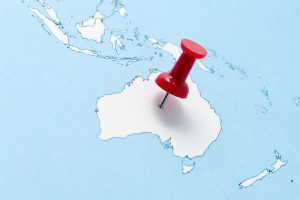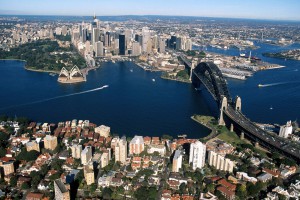Do apartments make good investments?
Well…some do and some don’t.
But as we change the way we’re living, the right apartment will make a good long term investment and in this article I’m going to present a lot of data from the most recent Census to help you decide what makes a good “investment grade” apartment.

Thats’s because I believe demographics will hold the key to the future of our property markets.
How many of us there are, how we want to live and where we want to live will be a more important factor shaping our future property markets than the short term ups and downs of supply and demand, consumer sentiment or interest rates.
This means understanding Australia’s lifestyle and demographic trends will provide you with the type of insight you need for constructing a successful property investment portfolio.
More Australians than ever are taking up apartment living, whether out of preference, convenience, or for other reasons.
Here’s what the A.B.S has to say about this trend…
The 2016 Census of Population and Housing found that 10% (2,348,434) of all people in Australia spent Census night in an apartment.
There is now around one occupied apartment for every five occupied separate houses in Australia – compared with one to every seven, back in 1991.
Apartment living has been brought about by the demographic trend of swapping space for place – people are trading their backyards for balconies and courtyards in the inner suburbs, where their jobs are and where they are closer to better amenities and is primarily an urban phenomenon, concentrated within Australia’s major capital cities.
Along with this has come a more cosmopolitan lifestyle, there are more one and two person households where living in a house with a large back yard doesn’t make sense.
These demographic trends have some important implications.
Apartment living is on its way to becoming more popular than ever; it is certainly superseding the quarter acre block as the great Australian dream.
These changes in Australia’s lifestyle preferences are indeed having a ripple effect on the economy and they also mean significant and lasting changes to the real estate market.
NUMBER OF OCCUPIED APARTMENTS
Over the past 25 years, the number of occupied apartments (including flats and units, excluding townhouses) in Australia has increased by 78% to 1,214,372 dwellings at the 2016 Census.
There has been a steady increase in the number of apartments since 1991, although the Census shows slowing growth in the last five years.
Most notably, the number of occupied apartments increased by 20% between 1991 and 1996, then by almost 17% between 2001 and 2006.
Footnote(s): (a) Includes occupied flats, units and apartments.
Source(s): ABS Census of Population and Housing, 1991 – 2016.
COMPARISON WITH OCCUPIED HOUSES
While the number of occupied apartments has increased over the last 25 years, the number of occupied separate houses has also continued to grow (from 4,533,595 in 1991 to 6,343,419 in 2016).
There is now around one occupied apartment for every five occupied houses in Australia – compared with one for every seven in 1991.
Footnote(s): (a) Apartments include flats and units. Dwelling counts refer to occupied private dwellings only.
Source(s): ABS Census of Population and Housing, 1991 – 2016.
HIGH-RISE APARTMENTS
Apartments are associated with high-rise living.
Indeed, Census results confirm the rising prevalence of apartments in four or more storey blocks.
In 1996, nearly one in five (18%) of all Australia’s occupied apartments had this structural characteristic.
By 2016 this had more than doubled to 38% of all occupied apartments (or 463,557 in number) within four or more storey blocks.
Source(s): ABS Census of Population and Housing, 1991 – 2016.
WHERE ARE THE APARTMENTS?
States and Territories
Of the 1,214,372 occupied apartments in Australia in 2016, nearly half (47%) were in New South Wales, followed by 23% in Victoria and 17% in Queensland.
New South Wales also had the highest proportion of apartments relative to all occupied private dwellings (at 21%).
The Northern Territory was also prominent with 17% of its occupied private dwellings being apartments.
APARTMENTS: PERCENTAGE DISTRIBUTION BY STATE AND TERRITORY(a), 2016
|
|
||
| State/Territory |
As % of all apartments in Australia
|
As % of all occupied private dwellings in state/territory
|
|
|
||
| New South Wales |
47.2
|
20.7
|
| Victoria |
22.8
|
12.3
|
| Queensland |
17.4
|
11.8
|
| South Australia |
3.8
|
6.8
|
| Western Australia |
4.7
|
6.1
|
| Tasmania |
1.0
|
6.0
|
| Northern Territory |
1.1
|
17.0
|
| Australian Capital Territory |
2.0
|
16.0
|
|
|
||
| Australia(b) |
100.0
|
13.7
|
(a) Includes flats and apartments. Occupied private dwellings only.
(b) Includes details for the Other Territories.
Source: ABS Census of Population and Housing, 2016.
Capital Cities
Apartments were mostly located in the capital city regions.
Three capital cities contained over 90% of all occupied apartments in their State.
They were Melbourne (94%), Perth (92%) and Adelaide (91%).
The apartment share was more equal in Queensland, with Brisbane having 52% of Queensland’s total.
Footnote(s): (a) Greater Capital City Regions, ASGS. The ACT is treated as one region; hence there is no capital city/rest of territory split.
Source(s): ABS Census of Population and Housing, 2016.
PEOPLE IN APARTMENTS
In 2016, almost 10% (2,348,434) of people in Australia spent Census night in an apartment. 
Most (95%) were at their usual apartment home.
There were also 128,520 visitors staying in apartments, with 40.3% from overseas and the remainder visiting from elsewhere in Australia.
Over half (51%) of all people in Australia’s apartments on Census night, 2016, were counted in New South Wales.
This was more than double the 22% share recorded in Victoria.
New South Wales also had the most apartment visitors – at 51% of the national count.
Including visitors, the average number of people counted per apartment on Census night was 1.9. In comparison, the average number of people counted in separate houses was 2.8.
PERSONS COUNTED IN APARTMENTS BY STATE AND TERRITORY, 2016(a)
|
|
||
| State/Territory |
At their usual home
|
Total – including visitors(b)
|
|
|
||
| New South Wales |
1,138,736
|
1,196,187
|
| Victoria |
475,993
|
506,444
|
| Queensland |
356,233
|
381,099
|
| South Australia |
73,309
|
77,237
|
| Western Australia |
91,359
|
97,456
|
| Tasmania |
18,615
|
19,701
|
| Northern Territory |
25,751
|
27,878
|
| Australian Capital Territory |
39,599
|
42,061
|
|
|
||
| Australia(c) |
2,219,924
|
2,348,434
|
(a) Place of enumeration. Includes visitors from overseas or elsewhere in Australia – who were present in apartments on Census night.
(b) Includes details for the Other Territories.
Source: ABS Census of Population and Housing, 2016.
AGE AND SEX
Within the apartment dweller population
In 2016, 29% of all apartment residents (excluding visitors) in Australia were in the 25-34 age group.
Another 11% were children aged 0-14 years, up slightly from the 10% share recorded a decade earlier.
Source(s): ABS Census of Population and Housing, 2016.
The median age of males and females who usually lived in an apartment was the same (33 years).
This was much lower than the medians recorded for all males and females in Australia (37 and 38 years respectively).
People living in apartments were more likely to be female than male (51% compared with 49%) – mirroring the proportions observed for the overall population at the 2016 Census.
Females were also slightly more likely to be living in apartments in their later years than males, perhaps reflecting longer female life expectancy and different lifestyle and accommodation preferences. 
Compared with the overall population living in private dwellings
In 2016, one in five (21%) of all people aged 25-34 years (and living in private dwellings) were apartment residents.
Nearly one in eight (12%) of all persons aged 85 years or more – and 35-44 years – were also apartment residents.
Younger people were also quite prominent.
More than one in ten (11%) of Australia’s youth population (aged 15-24 years) resided in apartments.
Similarly, nearly one in ten (9%) of all children aged 0-4 years had an apartment home.
Footnote(s): (a) Total population counted in occupied private dwellings.
Source(s): ABS Census of Population and Housing, 2016.
REGIONAL DISTRIBUTION OF APARTMENT DWELLERS
In 2016, 85% of Australia’s apartment dwellers (excluding visitors) lived in capital city regions, with other concentrations mostly found along the eastern coast.
This distribution is shown by this map of Australia’s Statistical Area Level 4 (SA4) regions with capital city insets.
At the smaller Statistical Area Level 2 (SA2) geography, Melbourne SA2 (situated in the inner city) had the most apartment dwellers in Australia with 37,916 people, 88% of whom were counted at their usual home – with the rest being visitors from overseas or elsewhere in Australia.
Second ranked was Waterloo – Beaconsfield, just 5 km from the Sydney CBD, with 27,541 apartment dwellers. 
Once semi-industrial, this region has experienced new residential development, particularly in Beaconsfield, thus transforming the nature of the region. Also in Australia’s top 5 were Sydney – Haymarket – The Rocks, Parramatta – Rosehill and Perth City.
Melbourne was also notable in having 4,420 temporary visitors in its apartments on 2016 Census night, with 69% originating from overseas.
None of the other ‘top three’ SA2 regions across Australia matched these visitor levels.
Not all prominent apartment regions were in the inner capital city areas.
Regions such as Surfers Paradise, Mermaid Beach – Broadbeach, Glenelg, Nightcliff and Sandy Bay suggest a second view – that apartment living can also be beach-side living.
PERSONS COUNTED IN APARTMENTS – TOP THREE SA2 REGIONS IN EACH STATE AND TERRITORY, 2016(a)
|
|
||
| Statistical Area Level 2 Regions |
At their usual apartment home
|
Total counted(b)
|
|
|
||
| New South Wales | ||
| Waterloo-Beaconsfield |
26,079
|
27,541
|
| Sydney-Haymarket-The Rocks |
23,765
|
26,355
|
| Parramatta-Rosehill |
23,046
|
24,294
|
|
|
||
| Victoria | ||
| Melbourne |
33,496
|
37,916
|
| St Kilda |
17,650
|
18,614
|
| Southbank |
16,899
|
18,540
|
|
|
||
| Queensland | ||
| Surfers Paradise |
16,215
|
17,772
|
| Newstead-Bowen Hills |
8,427
|
8,905
|
| Mermaid Beach-Broadbeach |
8,129
|
8,781
|
|
|
||
| South Australia | ||
| Adelaide |
7,036
|
7,721
|
| Glenelg |
3,799
|
4,009
|
| Goodwood-Millswood |
3,338
|
3,484
|
|
|
||
| Western Australia | ||
| Perth City |
20,955
|
22,755
|
| Wembley-West Leederville-Glendalough |
4,733
|
4,967
|
| Subiaco-Shenton Park |
3,902
|
4,136
|
|
|
||
| Tasmania | ||
| Hobart |
2,435
|
2,648
|
| Sandy Bay |
1,422
|
1,523
|
| Glenorchy |
1,152
|
1,214
|
|
|
||
| Northern Territory | ||
| Darwin City |
5,170
|
5,722
|
| Larrakeyah |
1,831
|
2,046
|
| Nightcliff |
1,869
|
2,021
|
|
|
||
| Australian Capital Territory | ||
| Belconnen |
3,647
|
3,860
|
| Braddon |
3,426
|
3,690
|
| Kingston |
3,411
|
3,641
|
(a) Place of enumeration. (b) Includes visitors from overseas or elsewhere in Australia who were present in apartments on Census night.
Source: ABS Census of Population and Housing, 2016.
COUNTRY OF BIRTH
In 2016, more than four in every ten (44%) apartment residents were born in Australia. ![]()
Around one in ten (11%) were born in North – East Asia (which includes China and Hong Kong) and Southern and Central Asia, which includes India (9%).
From another perspective – and highlighting the multi-cultural nature of apartment living – only 6.7% of all Australian born people (who live in private dwellings) were living in apartments on Census night, 2016. This compares with 17% of all the overseas born population.
Over 31% of all people born in North-East Asia – and in Australia on Census night – were living in apartment homes.
There were also higher proportions of people born in Southern and Central Asia (26%) and the Americas (24%) counted in their apartment homes.
PERSONS COUNTED AT THEIR USUAL APARTMENT HOME BY COUNTRY OF BIRTH, AUSTRALIA, 2016
|
|
||
| Country of birth |
% of all persons in apartments
|
% of persons by Country of birth who live in apartments
|
|
|
||
| Australia (including the External Territories) |
44.2
|
6.7
|
| Oceania and Antarctica (excluding Australia) |
3.0
|
10.9
|
| North-West Europe |
6.2
|
10.4
|
| Southern and Eastern Europe |
3.2
|
11.7
|
| North Africa and the Middle East |
2.8
|
17.5
|
| South-East Asia |
6.5
|
17.4
|
| North-East Asia |
10.6
|
31.3
|
| Southern and Central Asia |
9.0
|
26.3
|
| Americas |
2.8
|
24.3
|
| Sub Saharan Africa |
1.7
|
12.6
|
| Other |
0.1
|
21.5
|
| Not stated |
9.7
|
16.1
|
|
|
||
| Total(a)(b) |
100.0
|
10.2
|
(a) Please note that there are small random adjustments made to all cell values to protect the confidentiality of data. These adjustments may cause the sum of rows or columns to differ by small amounts from table totals.
(b) Place of enumeration.
Source: ABS Census of Population and Housing, 2016
HOUSEHOLDS AND FAMILIES
In 2016, the most prevalent type of household living in apartments in 2016 were one family households at 48% – up from 45% in 2011.
The proportion of group households also rose, up from 8.7% in 2011 to 9.6% in 2016.
Families with children were also well represented in the apartment living population.
At the 2016 Census, families with children (and either one or two parents) comprised almost 44% of all families living in apartments in Australia.
The proportion of lone person households living in apartments has declined, down from 46% in 2011 to 42% in 2016.
Footnote(s): (a) Excludes visitor only households and other non-classifiable households. Two or more family households have been excluded; they comprised less than 1% of households in apartments in 2011 and 2016.
Source(s): ABS Census of Population and Housing, 2011 and 2016.
TENURE IN APARTMENTS
The 2016 Census showed that tenure for all apartments across Australia was:13% owned outright, 15% owned with a mortgage and well over half (59%) being rented. In contrast, 34% of separate houses were owned outright, 38% owned with a mortgage, and 21% rented.
Both Queensland and New South Wales were prominent in having almost 14% of occupied apartments owned outright.
In contrast, the ACT had the second lowest proportion of apartments owned outright (8%) but the highest proportion of mortgaged apartments (19%).
In all states and territories, the majority of apartments were rented.
The highest proportions were in Tasmania, the Northern Territory and South Australia where around two-thirds were rented (or 66%, 64% and 63% respectively).

Footnote(s): (a) Tenure type ‘not stated’ included in the calculation of percentages. (b) Includes apartments purchased under a shared equity scheme. (c) Includes apartments with free rental.
Source(s): ABS Census of Population and Housing, 2016.
The Bottom Line:
So now that you are up to speed on what’s happening with apartment living, you need to start thinking about how to intelligently invest in this type of property.
With all of this evidence, the debate about whether houses or apartments make a better investment just got a lot more interesting.
You really can’t stay stuck in the camp that believes property investment is all about land value and number of bedrooms.
At the very least, it is worth considering how to diversify your property portfolio to include an inner suburban one or two bedroom apartment.
BUT BE VERY CAREFUL…
Investing in apartments still requires the same comprehensive level of scrutiny and due diligence as free-standing homes and, like every type of property investment, there are some winners and some bad eggs out there. 
For example, there is a looming oversupply of inner city (CBD) apartments in Brisbane, Perth and to a lesser extent Sydney.
Some of the monoliths coming out of the ground are destined to be the slums of the future.
Plus, with the recent changes to investor lending, local investors are going to have difficulty settling their purchases and many foreign investors will have no chance of settling – most banks have pulled the rug out from under them and are no longer lending to foreign residents.
There’s a potential tsunami of failed settlements heading for our shores and many off the plan investors and some developers will get burned.
MY RECOMMENDATION IS…
Steer clear of off-the-plan apartments and look for properties with an element of scarcity.
I would look for an apartment in a sought-after inner or middle ring suburb, in a building that has a bit of ‘character’ and a good proportion of owner-occupiers.
And with capital growth likely to be lower in the coming years, I look for properties to which I can add value through renovations, rather than wait for the market to do the heavy lifting.
Apartment living looks set to be the way of life for the future and strategic investors need to work out how and when they are going to respond to this growing trend.
HOW TO AVOID THE APARTMENT ‘TIME BOMB’
If you’re looking for independent advice, no one can help you quite like the independent property investment strategists at Metropole.
Remember the multi award winning team of property investment strategists at Metropole have no properties to sell, so their advice is unbiased.
Whether you are a beginner or a seasoned property investor, we would love to help you formulate an investment strategy or do a review of your existing portfolio, and help you take your property investment to the next level.
Please click here to organise a time for a chat. Or call us on 1300 20 30 30.
When you attend our offices in Melbourne, Sydney or Brisbane you will receive a free copy of my latest 2 x DVD program Building Wealth through Property Investment in the new Economy valued at $49.
Read more : The Australian Bureau of Statistics


No comments:
Post a Comment